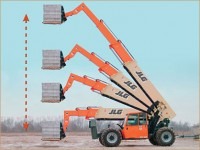Telehandlers
Compact sizes and new technologies in telehandlers give masonry contractors more options.
By Brett Martin
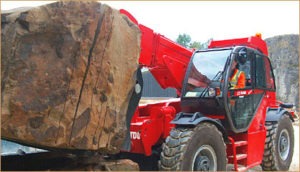 Reversing an earlier trend of bigger is better, masonry contractors are now buying small, compact telehandlers.
Reversing an earlier trend of bigger is better, masonry contractors are now buying small, compact telehandlers.
“In the past, the trend was for bigger, taller and more expensive telehandlers,” says Steve Kirst, product manager for Gehl Co. in West Bend, Wis. “Now these smaller units are the machine of choice on larger projects to shack down a jobsite and feed the tower cranes.”
Randy Vargason, product marketing manager for Mustang Manufacturing Co. Inc. in Owatonna, Minn., expects the trend to continue.
“Demand for compact units will continue to rise as people come to understand the value,” says Vargason. “It used to be that telehandler buyers would go for the largest machines possible, because there were a few times a year they would need that extra-large capacity or extreme reach. But now, contractors understand that it makes more sense to buy machines designed for the kinds of jobs they do the majority of the time, and then rent the larger units a few times a year.”
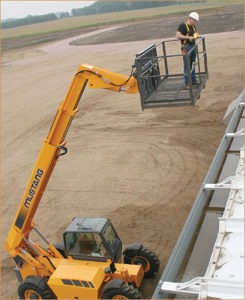 Growing demand for small telehandlers
Growing demand for small telehandlers
Compact telehandlers can maneuver in tight spaces, yet they can handle most masonry tasks. “Compact telehandlers are the fastest growing segment of the business. People are seeing the number of applications they have,” says Ryan Ford, product specialist for Manitou North America in Waco, Texas. “They can do 85 to 90 percent of the work of telehandler jobs. The only thing they can’t do is place materials at great heights.”
Brian Boeckman, product parent for North American telehandlers for McConnellsburg, Pa.-based JLG Industries Inc. says that in 2004, about 3,800 compact telehandlers were sold globally. Last year, that number shot up to 6,100.
“These are very versatile machines,” Boeckman says. “They have a lot of advantageous over skid steers, which are commonly used on jobsites, and end users are finding that they can do more with telescopic handlers.”
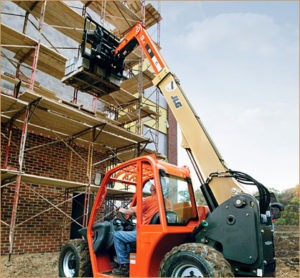 Last December, JLG unveiled its G5-18A super compact telehandler, which has a 5,500-pound lifting capacity, 11 feet of reach, and a 126-inch turning radius.
Last December, JLG unveiled its G5-18A super compact telehandler, which has a 5,500-pound lifting capacity, 11 feet of reach, and a 126-inch turning radius.
Gehl hit the market last year with a compact, low-profile telescopic handler, the RS5-19, which has 19 feet of lift and an 11-foot turning radius.
“Having 5,500 pounds of lift capacity, it can easily carry two cubes of bricks or blocks around the jobsite,” Kirst says. “Weighing less than 10,000 pounds, it can easily be towed behind a good-sized pickup truck, meaning no need for an expensive tractor trailer rig for hauling.”
Mustang’s 519 model offers 5,500 pounds of lift capacity and 19 feet of reach for two-story placement, Vargason says.
“The biggest advantage of the 519 is the ability to tow it behind a truck,” he says. “Not only is the cost to buy the machine lower, the cost to transport it is also low.”
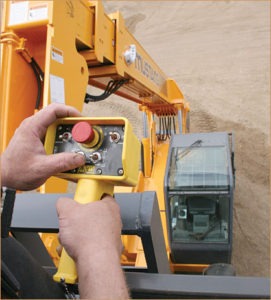
Better controls improve operations
New technologies give operators better, safer control of telehandlers. “Contractors are paying closer attention to safety, so machines equipped with standard, integrated safety systems, like Mustang’s Work Platform Safety System, are becoming more popular,” Vargason says, noting that workers can control and stop machine functions from the platform.
Worker efficiency is also important, he says. The company’s radio remote boom control lets operators control the boom from the work platform. Operators can shut down or start the engine remotely.
Manitou’s newest telehandler, the MRT 2150P, has a larger cab with better visibility and more ergonomic controls, Ford says. Some models feature LPS joystick controls, a dual level system for better efficiency placing and picking up loads.
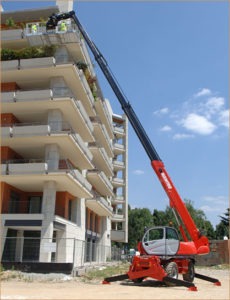 “It’s very easy to use,” Ford says. “Your hand just kind of folds into it. It’s a very user friendly interface.”
“It’s very easy to use,” Ford says. “Your hand just kind of folds into it. It’s a very user friendly interface.”
JLG offers AccuPlace with Ride Control on its G10-55A and G12-55A models. The boom extends and moves in a linear motion, rather than an arc, Boeckman says. AccuPlace moves the boom 12 percent faster.
“It gives the operator finer, more precise control of the machine,” he says. “If you’re a mason who does a lot of work on scaffolding, this places the load without rocking the scaffolding, without startling the guys working on it, and it takes a lot of pressure off the operator. This takes a novice operator and makes him look like a pro.”
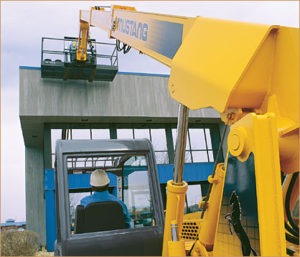 AccuPlace uses a new hydraulic system that reduces leak points by 27 percent, Boeckman says. “It reduces the number of connection points, which reduces the potential for leaks.”
AccuPlace uses a new hydraulic system that reduces leak points by 27 percent, Boeckman says. “It reduces the number of connection points, which reduces the potential for leaks.”
Ride Control keeps loads more secure, he says. It creates a suspension system for the boom, which buffers the boom when driving on rough terrain.
“Ride Control absorbs the rough terrain so you can transport a pallet of bricks or blocks [more safely],” he says. “It helps stabilize the load, so things won’t fall off as they’re being transported.”
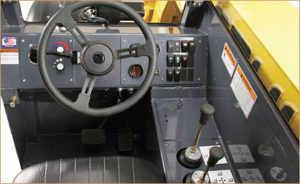
Buying a new telehandler
Since masonry contractors have loads of options when buying telehandlers, they should choose a model that fits their everyday work needs, rather than tying up money in an unnecessary large unit, manufacturers say.
“Buy for the typical job, rather than for the one or two large jobs that may come alongÉyou can always rent for those situations,” Mustang’s Vargason says. “For masonry contractors, the availability of different fork attachments is important, as are flat-proof tires. Man baskets with protection offered by approved safety systems already integrated into the machine are key. Mobility is also a big advantage to masons, as they are often working on sites where much of the construction has been raised.”
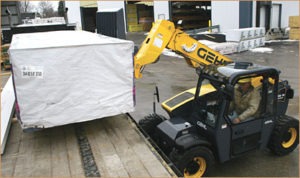 Contractors should consider personal preferences for operational and joystick controls, JLG’s Boeckman says.
Contractors should consider personal preferences for operational and joystick controls, JLG’s Boeckman says.
“You need to get in the machine and make sure that’s what you feel comfortable with,” he says. Telehandler applications, including boom length and lifting capacity, available attachments, and company support after the purchase are important.
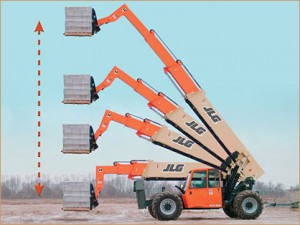 Vargason says he’s seeing increased demand for high lift and height capacities as masonry contractors want more from their machines.
Vargason says he’s seeing increased demand for high lift and height capacities as masonry contractors want more from their machines.
“At the same time, buyers are looking for fewer frills,” Vargason says. “They want high performance, but don’t necessarily need all the bells and whistles. This is likely due to the fact that telehandlers are task machines, meaning operators aren’t behind the wheel for hours at a time.”
